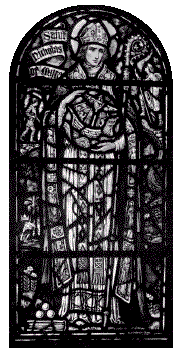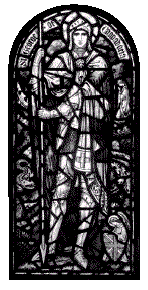Working in the Connick Archives Now and Then
by Noreen O'Gara
In 1982 I was working at the Boston Public Library as
a fine arts librarian and I was seeking a topic for my masters thesis in
order to complete my degree in Art History from Tufts University. Since
I worked full time it was important to find something I could research
in the Boston area. I was drawn to American art and architecture but my
main focus was art from the Medieval period. Finally, wiser heads than
mine pointed me in the right direction - Harcourt Street. Thanks to my
professors, Madeline Caviness and the late Margaret H. Floyd, I found the
perfect subject - Charles J. Connick! Here was an American stained glass
artist who was inspired by the Gothic art that I loved. Best of all, his
studio was still in operation and it was right around the corner from the
library.
I was able to spend hours in Harcourt Street talking to
the craftsmen, particularly Ralf and Harald Nickelsen and Louis Comacho,
who had worked in the studio for many years. Orin Skinner, President of
the Connick Associates, was a great source of information and a marvelous
storyteller. I was not just doing research I was being entertained, too.
The last two office managers, Kai Ketchen and Becky Breymann, graciously
helped me track down every letter, file, and photograph I needed. It was
wonderful experience and my thesis "Charles J. Connick: the Early Years"
would never have been completed without the cooperation of the Connick
Associates.

St. Nicholas of Myra, patron saint of schoolboys,
chancel window (1919) in chapel at Saint Mark's School, Southborough, MA.
Photograph courtesy of the Trustees of the Boston
Public Library.
|
Twenty years later I am delighted to be working on Connick
again and although I left the BPL in 1989 the Connick Archives arrived
there shortly after the studio closed its doors in 1987. The archive is
well organized and easy for any researcher to use if they let the Fine
Arts Department know in advance what their needs are and what files they
wish to access. My anxious emails and desperate phone calls are always
answered in a kind and helpful manner. The staff is also very knowledgeable;
their suggestions have led me to supplemental information, such as, web
sites related to specific commissions. Their assistance is much appreciated.
The Connick Archive includes a number of beneficial tools
for researching stained glass windows. These include a list of windows
by geographic location in one set of notebooks and another set of notebooks
containing the job sheets in chronological order starting with #551 (1914).
There are also typescripts with a list of books from the studio's library
and a numerical list of jobs beginning with number 500 (1912). Files include
photographs of the actual windows as well as the designs upon which they
were based, descriptions of the windows that identify and explain each
commission's iconography, and finally the correspondence files for individual
jobs. All of these resources are helpful for the researcher but the correspondence
files provide the greatest insight into Connick and his circle.
The files for St. John the Divine Cathedral, New York
City, for example, contain materials written over a period of nearly thirty
years. The earliest letters date from 1913 and concern a small commission
for the Synod House but the folders also include materials written as late
as 1940. The documents in the correspondence files illuminate Connick's
dealings with Ralph Adams Cram. The early letters are somewhat careful
and formal, while the honesty and warmth of their friendship shines through
their later correspondence. Connick's dealings with the other glassmen
whose works appear in the Cathedral are documented here as well. In 1914
and again, in 1917, Connick, D'Ascenzo, and Heinigke appeal to Cram to
hire American, not English, stained glass studios to fill the lights of
the great Cathedral. In the 1930s there are several references to meetings
hosted by Cram to discuss using harmonious colors and figure styles among |
all the stained glass craftsmen who were working on the Cathedral.
The tones of these letters are always amiable and respectful. The files
also demonstrate how Connick dealt with the clergy at the Cathedral. His
earliest relations with Canon Jones were cordial and Jones even deferred
to Connick's greater knowledge of iconography in a letter dated May 9,
1921. Relations with Jones' successor, Rev. B. Talbot Rogers, were less
happy. After a steady stream of complaints and concerns by Rogers, Connick
wrote to Cram in frustration "I wonder if you know this Dr. Rogers who
is pestering me with these pernicious notes? I have been told that I should
pay no attention to him, but at the same time such miserable suspicions
hurt my feelings, to say the least....Here is an excellent indication that
the art of stained glass is a lost art, and so I jump into my book again,
with renewed vigor." (September 23, 1933).
|
Continued on the OVERLEAF.
|
|
 |
Grateful thanks to all those who
kindly gave recent contributions to The Connick Foundation supporting the
ongoing work of newsletters and annual lectures along with our special
projects of films, books and exhibitions helping people to understand the
inspiring beauty of stained glass. |
 |
Please address questions, comments
and/or gifts to Marilyn B. Justice, President, at The Connick Foundation. |
|
 |
While Connick tried hard to make his patrons happy and
responded to their many concerns and queries with patience, he did not
display the same forbearance with members of his own staff. He wrote to
Paul Child (Julia's husband) regarding the windows he was designing for
the American Church in Paris on January 23, 1930. The letter begins abruptly:
"Perhaps you have forgotten some of the details of the craft that you learned
long ago - else you would not be surprised that I want actual sizes for
all the windows even though only the cartoons are to be made here." Connick
continues with a lengthy list of instructions and then precedes to discuss
salary and payment before he ends on a more conciliatory note by thanking
Child for shipping a Lalique bird from Paris and sends greetings "to all
your folk."
The Connick Archive is filled with many wonderful letters,
drawings, and photographs waiting to be uncovered. Scraps of paper covered
with notes and sketches, scribbled drawings on the margins of letters all
add to the sense of immediacy and discovery for the lucky researcher. Many
of the stories and anecdotes I heard from Mr. Skinner and the other craftsmen
at the studio can be rediscovered in these files. The Archive contains
rich rewards for anyone interested in the history of American stained glass,
American architecture or even the cultural life of Boston in the twentieth
century.
Noreen O'Gara works as the young adult and reference librarian
at the Bedford Free Library, Bedford, MA. |
St. George of Cappadocia, chancel window
(1919) in chapel at Saint Mark's School,
Southborough, MA. Photograph courtesy of the Trustees
of the Boston Public Library. |
|
Connick Windows
"I want to make beautiful interiors for both churches
and souls
I want...[all people] to hear my windows singing..."
Charles J. Connick |
|
|
|

